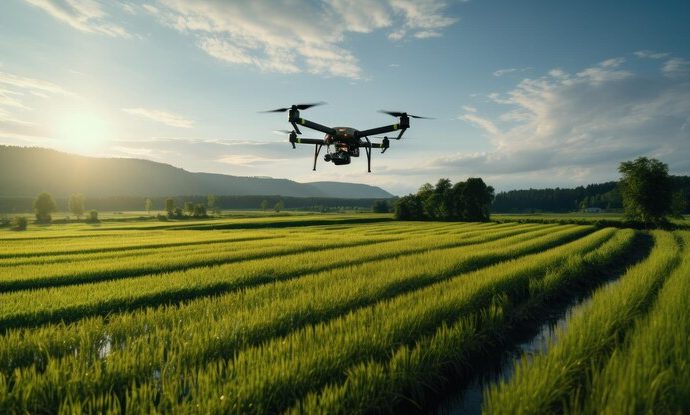Drone pesticide spraying has been a game-changing tool in agriculture in recent years, transforming crop protection methods. The agriculture drone industry is expected to increase at a 20.3% yearly pace from its 2023 valuation of $4.98 billion to $18.22 billion by 2030. The growing use of drones for productive and sustainable farming is reflected in
Drone pesticide spraying has been a game-changing tool in agriculture in recent years, transforming crop protection methods. The agriculture drone industry is expected to increase at a 20.3% yearly pace from its 2023 valuation of $4.98 billion to $18.22 billion by 2030. The growing use of drones for productive and sustainable farming is reflected in this spike. With the help of case studies and actual situations, we will examine the advantages, difficulties, developments in technology, and prospects for drone pesticide spraying in this extensive piece.
Why Choose Drone Pesticide Application?
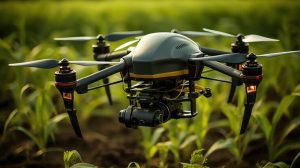
Image by unsplash.com
The demand for accuracy, effectiveness, and environmental sustainability is what is driving the move to drone pesticide application. In these situations, conventional aerial and ground sprayers frequently fall short. Conversely, drones provide answers to contemporary agricultural problems.
Precision Farming and Spraying on Specific Areas
Precision gardening is made easier by drones, which can drop pesticides precisely where they are needed. Drones with GPS and high-tech sensors can find bug infestations and only spray the areas that need it. This greatly reduces the use of pesticides and their negative effects on the environment. This accuracy also lowers the chance that chemicals will run off into nearby bodies of water, which happens a lot when spreading chemicals the old way.
Example: A vineyard in California used drones to apply fungicides precisely on infected grapevines, reducing chemical usage by 40% and improving overall grape quality. The vineyard’s owner noted significant cost savings and an increase in yield, demonstrating the potential of precision drone technology.
Reduced Soil Compaction and Crop Damage
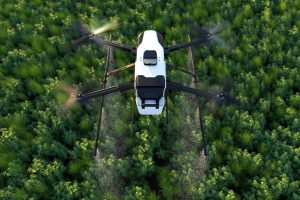
Image by unsplash.com
Traditional ground sprayers can cause soil compaction, negatively affecting crop health and yield. Drones, being lightweight and airborne, eliminate this issue. This is especially beneficial for fields with delicate crops or wet soil conditions that cannot support heavy equipment.
Case Study:
An Ohio-based corn farm experienced a 15% increase in yield after switching to drone pesticide application. The farm’s owner attributed this improvement to the reduced soil compaction and minimized crop damage. The drones were able to cover the fields efficiently, even in wet conditions, ensuring timely and effective pest control.
Efficiency in Spot Spraying and Weed Control
Spot spraying is another area where drones excel. In fields where certain weeds have developed herbicide resistance, drones can identify and target these weeds specifically, avoiding unnecessary pesticide application over the entire field. This approach saves costs and ensures better weed control.
Real-World Example: Dr. Jeff Stachler from Montana State University tested drone technology for spot spraying herbicide-resistant weeds in soybean fields. The drones accurately identified and sprayed the weeds, resulting in a 25% reduction in herbicide use and improved overall weed management.
Key Benefits of Drone Pesticide Spraying
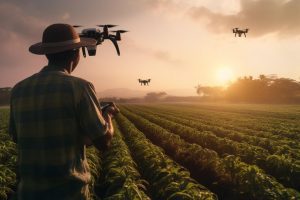
Image by unsplash.com
The advantages of drone pesticide application extend beyond precision and efficiency. Here are some notable benefits that make this technology attractive to farmers and agribusinesses.
Cost-Effectiveness and Labor Savings
While the initial investment in drone technology may be high, the long-term savings are significant. Drones can cover fields faster and with fewer resources compared to traditional methods. They are particularly cost-effective for small and irregularly shaped fields where conventional equipment may be inefficient.
Example: In Japan, drones are used to spray over 30% of the country’s rice fields. Farmers have reported labor cost savings of up to 40% and reduced fuel expenses, making drone technology a financially viable option.
Timely Application During Critical Periods
Crop diseases and pest infestations often require immediate intervention. Drones can be deployed quickly, ensuring that pesticides are applied at the right time to prevent crop damage. This timeliness is crucial in preventing the spread of pests and diseases, which can devastate entire fields.
Case Study:
A wheat farm in Kansas faced a sudden outbreak of rust disease. The farm used drones to apply fungicides swiftly, covering 100 acres in just a few hours. The rapid response prevented significant yield loss and saved the farm thousands of dollars in potential damage.
Enhanced Safety for Applicators
Pesticide application can be hazardous, especially for workers using backpack sprayers. Drones eliminate the need for human exposure to harmful chemicals, reducing health risks for applicators. They are also ideal for spraying in areas that are difficult or dangerous for humans to reach, such as steep hillsides or wetlands.
Example: In a hilly region of Italy, drones were used to spray vineyards located on steep slopes. The traditional method of manual spraying posed safety risks to workers, but drones provided a safer and more efficient alternative.
Environmental Sustainability
Drone technology promotes sustainable agriculture by reducing chemical usage and minimizing environmental impact. The precise application of pesticides prevents over-spraying and reduces the risk of chemical runoff into waterways. Additionally, the lower fuel consumption of drones compared to traditional aircraft contributes to reduced carbon emissions.
Challenges and Regulatory Hurdles
Despite the numerous benefits, drone pesticide application faces several challenges, particularly in the regulatory landscape.
Regulatory Restrictions by the FAA
The Federal Aviation Administration (FAA) imposes strict regulations on drone operations. Drones must weigh 55 pounds or less, including payload, and pilots must maintain a visual line of sight. Additionally, drone operators need to obtain FAA Part 107 and Part 137 certificates for legal pesticide application. These regulations, while essential for safety, can limit the widespread adoption of drones in agriculture.
Case Study:
A farming cooperative in California applied for an FAA exemption to use larger drones for pesticide application. The exemption allowed them to cover vineyards more efficiently, but the approval process took several months, highlighting the regulatory challenges farmers face.
Lack of Standardization in Drone Designs
Unlike conventional spraying equipment, drone designs and configurations vary widely. There is no universal standard for nozzle placement, spray width, or droplet size, making it difficult for farmers to choose the right drone. This lack of standardization also complicates research and performance comparisons.
Research Insight:
Studies by The Ohio State University have shown that drone performance varies significantly based on design parameters. The university is conducting research to establish guidelines for optimal drone configurations, but more work is needed to create industry-wide standards.
Battery Life and Limited Tank Capacity
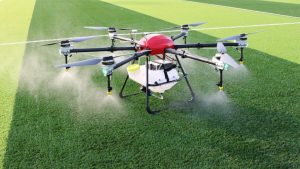
Image by Yandex.com
Current drone models have limited battery life, typically lasting 5-15 minutes with a full tank. This requires frequent recharging and refilling, which can be time-consuming for large fields. However, advancements in battery technology and larger tank capacities are on the horizon.
Example: DJI, a leading drone manufacturer, is developing drones with extended battery life and 10-gallon tanks, aiming to improve efficiency and reduce downtime.
Technological Advancements and Future Prospects
The future of drone pesticide application is promising, with continuous advancements in technology and potential regulatory changes. Here are some key trends to watch:
Swarming Technology for Large-Scale Spraying
Swarming, or the use of multiple drones operated by one pilot, is already practiced in countries like China and South Korea. The FAA is considering easing restrictions on swarming, which could revolutionize large-scale pesticide application. This technology would allow multiple drones to work simultaneously, covering vast areas more efficiently.
Example: In China, swarming technology is used to spray large rice fields, significantly reducing labor costs and improving coverage. The technology has been instrumental in managing crop protection during critical periods.
Advanced Sensors and AI Integration
Future drones will feature advanced sensors and AI algorithms for precision spot spraying and variable-rate application. These technologies will enable drones to analyze real-time data and adjust the amount of pesticide sprayed based on field conditions. This level of precision will further reduce chemical usage and enhance environmental sustainability.
Larger Drones with Improved Capabilities
Manufacturers are developing larger drones with higher payload capacities and longer battery life. These drones will be able to cover more acres per flight, making them suitable for large-scale farms. Additionally, improved obstacle avoidance systems and real-time kinematics (RTK) technology will enhance the safety and efficiency of drone operations.
Demonstrating the Impact of Drone Technology
Several case studies highlight the effectiveness and potential of drone pesticide application in real-world scenarios.
Rice Fields in Japan
In Japan, drones are widely used to spray rice fields. A study conducted in 2020 found that drone spraying reduced labor costs by 40% and pesticide usage by 30%. The drones’ ability to navigate narrow pathways and spray precisely contributed to healthier crops and higher yields. This case study underscores the economic and environmental benefits of adopting drone technology.
Corn and Soybean Farms in the United States
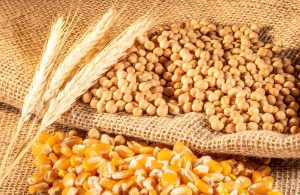
Image by Yandex.com
A large-scale corn and soybean farm in the Midwest experimented with drone spraying for fungicides and herbicides. The drones covered 300 acres in a day, compared to three days required by traditional equipment. The farm reported a 20% increase in yield and a significant reduction in chemical costs. Additionally, the drones minimized soil compaction, contributing to healthier crops.
Economic and Environmental Effects
Using drones to apply pesticides has several advantages for the environment and the economy in addition to efficiency.
Decreased Chemical Use and Preservation of the Environment
When pesticides are applied precisely, there is less chance of chemical runoff, safeguarding surrounding waterways and wildlife habitats. This strategy fits perfectly with the increased focus on environmentally friendly agricultural methods. Drones also use less fuel than conventional airplanes, which helps to reduce carbon emissions.
Benefits to Small and Medium-Sized Farms Economically
Drone technology can greatly aid small and medium-sized farms, but large farms may still rely on conventional methods. Drones are a good alternative for farms who cannot afford pricey ground or aerial equipment because of the labor cost savings and production gains.
Example: A small organic farm in Oregon used drones for spot spraying to manage pest outbreaks. The farm saved thousands of dollars in labor costs and reported a 15% increase in crop yield, demonstrating the economic potential of drone technology.
Conclusion
Agriculture is changing as a result of drone pesticide spraying, which provides an effective and sustainable substitute for conventional techniques. The future is bright, despite lingering obstacles including design standardization and regulatory barriers. Drones are expected to become increasingly important in contemporary farming as a result of technological breakthroughs and more lenient laws.
Farmers that are considering this technology should keep up with the most recent findings, changes to regulations, and industry best practices. Drones are changing the game, whether it’s for precision farming, spot spraying, or getting to hard-to-reach places. Drones’ potential to transform agriculture is becoming more and more clear as the sector develops.

